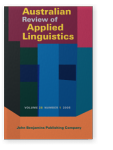Spelling correction strategies employed by learners of Japanese
This article analyzes the self-correction of spelling by learners of intermediate Japanese. Participants in this study consisted of 20 students with kanji (Chinese characters) background and 43 without. This study investigates (1) types of spelling errors made; (2) the success rate of corrections made when codes for types of errors (error-codes) were given; (3) strategies used for correcting spelling errors; (4) reasons for a failure to correct errors; and (5) measures for further improvement in correction rates. Three methods, including ‘think-aloud’, observation notes, and the writing of an essay before and after corrections, were used as research tools. The findings show a high rate of success in the self-correction strategies. The errors made by the students may be attributed to a number of different causes. On the basis of the findings, this article puts forth the following suggestions, among others: the provision of increased time for corrections, of more detailed instruction in kanji, and of correct pronunciation instruction; increased practice in the use of dictionaries; and improved codes to indicate types of errors.
References (19)
Akamatsu, N.
(
2003)
The effects of first language orthographic features on second language reading in text.
Language Learning, 53 (2), 207–231.


Chikamatsu, N.
(
1996)
The effects of LI orthography on L2 word recognition. A study of American and Chinese learners of Japanese.
Studies in Second Language Acquisition, 181, 403–432.


Hatta, T., Kawakami, A. & Hatasa, Y.
(
1997)
Kanji writing errors in Japanese college students and American Japanese learners. In
H. Chen (Ed.)
Cognitive processing of Chinese and related Asian languages (pp. 401–416). Hong Kong: The Chinese University Press.

Henshall, K.G.
(
1988)
A guide to remembering Japanese characters. Tokyo: Charles E. Turtle Company.

Ishida, T.
(
2000)
Kanji no shidoohoo (Hi-kanjikei). In
A. Kato (Ed.)
Koza Nihongo to Nihongo kyooiku 9. Nihongo no moji hyooki (Ge) (pp. 290–312). Tokyo: Meijishoin.

Ishibashi, R.
(
2000)
Nihongo gakushuushano sakubun ni okeru monitaa nooryoku.
Nihongo Kyooiku, 1061, 56–65.

Kawaguchi, Y., Kano, C. & Sakai, J.
(
1995)
Kanji shidoo aideabukku. Tokyo: Sootakusha.

Koda, K.
(
1999)
Development of L2 intraword orthographic sensitivity and decoding skills.
The Modern Language Journal, 831, 51–64.


Komiya, C.
(
1991)
Suikoo ni yoru sakubun shidoo no kanoosei-gakushuusha no nooryoku o ikashita teisei.
Nihongo Kyooiku, 751, 124–135.

Oguma, T.
(
2001)
Eigobogowasha ni yoru choon to tan’on no chikaku.
Sekai no Nihongo Kyooiku, 101, 43–55.

Paltridge, B.
(
1994)
Portfolio assessment and the second language methods course.
The teacher trainer, 8 (2), 3–5.

Ryu, S.
(
1984)
Chuugokujin gakushuusha ni yoku mirareru hatsuon-joo no ayamari to sono kyoosei hoohoo.
Nihongo Kyooiku, 531, 93–101.

Sakamoto, T. & Koyama, S.
(
1997)
Nihongo gakushuusha no bunpoo shuusei nooryoku.
Daini gengo to shite no Nihongo Shuutoku Kenkyuu (Acquisition of Japanese as a second language), 11, 9–28.

Sakoda, K.
(
2002)
Nihongo kyooiku ni ikasu daini gengo shuutoku kenkyuu. Tokyo: Aruku.

Takebe, Y.
(
1993)
Kanji wa muzukashikunai 24 no hoosoku de subete no kanji ga masutaa dekiru. Tokyo: Aruku.

Toda, T.
(
1997)
Strategies for producing mora timing by non-native speakers of Japanese.
Acquisition of Japanese as a second language, 11, 157–197.

Victorian Board of Studies
(
1998)
LOTE compendium of assessment advice. Melbourne: Victorian Board of Studies.

Watanabe, H.
(
2002)
Essential Japanese kanji workbook-Coco and the gold flute, Kanji Dojo. Melbourne.

Cited by (2)
Cited by 2 other publications
Kuan, Wee-Ling
2021.
An Error Analysis of Orthographic Representation in Written Chinese Characters.
Journal of Cognitive Sciences and Human Development 7:2
► pp. 1 ff.

Mori, Yoshiko & Junko Mori
2011.
Review of recent research (2000–2010) on learning and instruction with specific reference to L2 Japanese.
Language Teaching 44:4
► pp. 447 ff.

This list is based on CrossRef data as of 29 june 2024. Please note that it may not be complete. Sources presented here have been supplied by the respective publishers.
Any errors therein should be reported to them.
